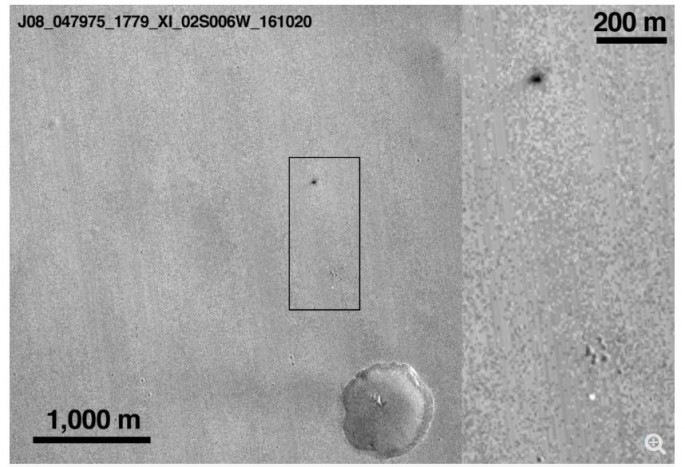The European Space Agency (ESA) has declared the mission of the Schiaparelli EDM (Entry, Descent and Landing Demonstrator Module) lander a success despite the lander having been destroyed on impact with Mars last Oct. 19.
Schiaparelli was apparently done in by a combination of two fatal errors, said ESA based on telemetry from the doomed probe. Initial analysis of returned telemetry suggests the heat shield and parachute deployment worked as expected, but the parachute was released too soon.
And to compound this already fatal error, the nine rocket thrusters that should have safely slowed down Schiaparelli fired for only three seconds instead of the expected 30 seconds. ESA believes Schiaparelli, which was falling faster than 300 km/h, exploded on impact since its thruster fuel tanks were almost full.
This notwithstanding, ESA declared Schiaparelli a success because it had fulfilled its primary function of testing the landing system for the ExoMars 2020 surface platform and for the telemetry data retrieved.
Confirmation of Schiaparelli's sad fate was seen in "new markings on the surface of the Red Planet" captured by NASA's Mars Reconnaissance Orbiter (MRO). ESA is now analyzing data recorded by the lander's mothership, the Trace Gas Orbiter (TGO), to understand what went wrong.
Images taken by MRO's Contest Camera showed remnants of what is believed to be the lander's 12 meter diameter parachute used in the second stage of Schiaparelli's descent, after the initial heat shield entry.
The parachute and the associated back shield were released from Schiaparelli prior to the final phase, during which its nine thrusters should have slowed it to a standstill just above the surface.
There's also a "fuzzy dark patch" 15 meters x 40 meters in size and about 1 km north of the parachute that might be the remains of Schiaparelli. Scientists believe this patch was created by the impact of Schiaparelli following a much longer free fall than planned. Estimates are that Schiaparelli plunged from a height of between 2 and 4 kilometers.
ESA said these two "features" were absent from the Mars surface on earlier images taken by the same camera.
Were Schiaparelli to have landed safely it would have activated its DREAMS (Dust Characterization, Risk Assessment, and Environment Analyzer on the Martian Surface) package.
This sensor consists of a suite of sensors to measure the wind speed and direction (MetWind), humidity (MetHumi), pressure (MetBaro), surface temperature (MarsTem), the transparency of the atmosphere (Optical Depth Sensor; ODS), and atmospheric electrification (Atmospheric Radiation and Electricity Sensor; MicroARES).
The DREAMS payload was intended to function for 2 to 8 Mars days as an environmental station for the duration of the surface mission after landing.
It was hoped DREAMS would have provided new insights into the role of electric forces on dust lifting, the mechanism that initiates dust storms.
In addition to the surface payload, a camera called DECA (Entry and Descent Module Descent Camera) would have delivered additional scientific data and exact location data in the form of images.
Schiaparelli's partner, the ExoMars TGO orbiter, is currently on a 101,000 km x 3,691 km orbit (with respect to the centre of the planet) with a period of 4.2 days, well within the planned initial orbit. The spacecraft is working very well and will take science calibration data during two orbits in November.
Together, both constituted ExoMars (Exobiology on Mars), and were the first of a two-part Martian astrobiology project to search for evidence of life on Mars. ExoMars is a joint mission of ESA and the Russian Federal Space Agency (RFSA). The second part will launch in 2020 and will land a rover on Mars.



























